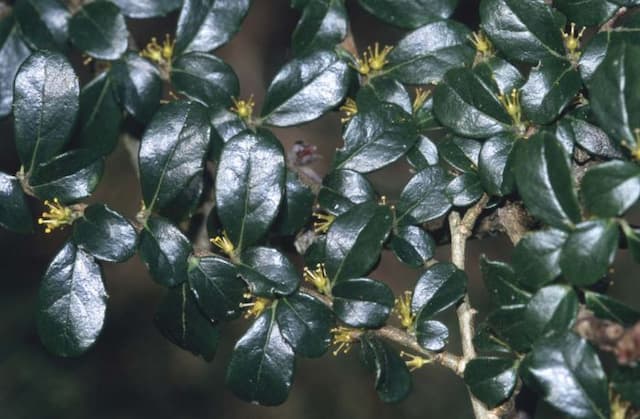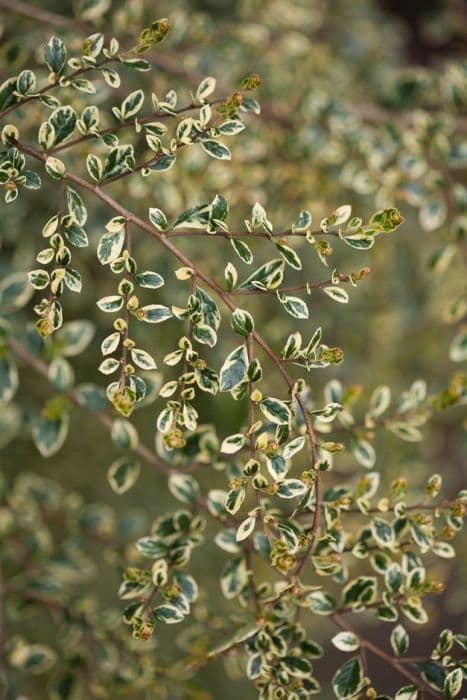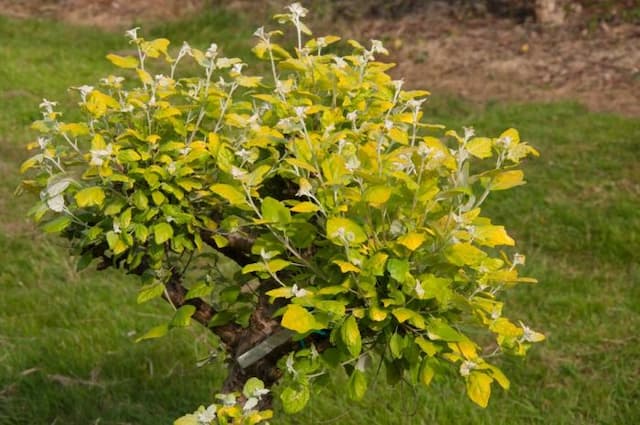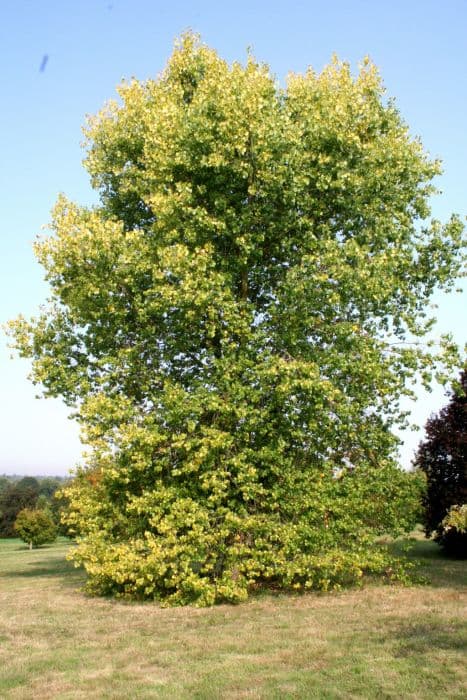Violet Willow Salix daphnoides

ABOUT
The plant commonly known as violet willow is distinguished by its striking appearance, featuring colorful stems and attractive foliage. This plant typically flaunts deep purple or violet-colored twigs, which exude a vivid contrast against natural green surroundings, especially noticeable during the winter months when color is scarce. The surface of the twigs is smooth, with a glossy finish that can catch the light and seem almost metallic—an aesthetic highlight in any garden setting. As for the leaves, the violet willow produces long, narrow foliage that has a fine texture. The leaves are bright green on the upper side, with a slightly paler green underneath, and are arranged alternately along the stems giving the plant a lush, full look. During the growing season, the leaves may turn a rich yellow, adding a new layer of visual interest before they fall, marking the transition into the dormant winter period. Flowers also play a role in the ornamental value of this willow. The blooming period sees the emergence of catkins—these are slender, cylindrical flower clusters that can range in color from yellow to silvery green, depending on the sex of the plant, since willows are typically dioecious with individual plants being either male or female. The catkins add a soft and delicate texture to the plant's profile. After flowering, female plants may produce small fruit capsules that add an additional decorative element. Overall, the violet willow is known for its vibrant stem coloration and charming catkins, contributing to its visual appeal through multiple seasons. With its striking features, this plant is often used for ornamental purposes to enhance the aesthetic of winter gardens, waterside plantings, and natural-style landscapes.
About this plant
 Names
NamesFamily
Salicaceae
Synonyms
Violet Willow, Daphne Willow, European Violet-Willow
Common names
Salix daphnoides var. acutifolia, Salix acutifolia.
 Toxicity
ToxicityTo humans
Salix daphnoides, commonly known as violet willow, is not typically considered to possess significant toxicity to humans. Some people might experience mild allergic reactions if they have certain sensitivities or allergies to willow bark or salicylates, which are precursors to aspirin. Generally, ingesting small amounts of the bark, which contains salicin—a substance that is metabolized into salicylic acid in the body—may lead to discomfort or gastrointestinal upset, similar to that which can occur with aspirin ingestion. However, it is not commonly consumed and the plant is not regarded as notably toxic to humans.
To pets
Violet willow is not known to be significantly toxic to pets such as dogs and cats. While the salicin in willow bark can have medicinal properties and is related to the active ingredient in aspirin, it typically does not cause poisoning in pets when ingested in small quantities. However, as with humans, pets with certain sensitivities may experience mild gastrointestinal upset or allergic reactions if they consume parts of the violet willow. It’s always prudent to monitor pets and prevent them from ingesting large amounts of any non-food plants, as individual animals might react differently.
 Characteristics
CharacteristicsLife cycle
Perennials
Foliage type
Deciduous
Color of leaves
Green
Flower color
Yellow
Height
13-26 feet [4-8 meters]
Spread
13-26 feet [4-8 meters]
Plant type
Tree
Hardiness zones
4-8
Native area
Europe
Benefits
 General Benefits
General Benefits- Erosion Control: Salix daphnoides, commonly known as violet willow, has extensive root systems that help stabilize soil and prevent erosion along riverbanks and slopes.
- Habitat Creation: The dense branching structure provides shelter and nesting sites for various bird species, as well as habitable spaces for insects.
- Aesthetic Appeal: With its striking violet or dark red twigs, especially prominent in the winter, it offers a splash of color to landscapes and gardens.
- Streambank Stabilization: Its likely growth in waterside environments aids in maintaining streambank integrity against the flow of water.
- Windbreak: When planted in rows, the violet willow can act as a windbreak, protecting crops, soil, and buildings from strong winds.
- Fast Growth: It is a rapidly growing plant, which can be advantageous for quickly establishing coverage or achieving ornamental effects in a relatively short time.
- Pollinator Support: Flowers provide an early source of nectar for bees and other pollinating insects, helping to bolster local ecosystems.
- Privacy Screening: Due to its dense foliage and quick growth, it can serve as an effective natural screen for privacy.
- Soil Improvement: Leaves and branches that fall and decompose contribute to soil enrichment by adding organic matter.
- Wildlife Food Source: The catkins provide food for wildlife in early spring when other food sources are scarce.
 Medical Properties
Medical Properties- Anti-inflammatory: Salix daphnoides contains compounds such as salicin which, when ingested, can be converted into salicylic acid, playing a role in reducing inflammation and possibly benefiting conditions associated with inflammation.
- Analgesic: Due to the presence of salicin, a precursor to aspirin, this plant is believed to have pain-relieving properties.
- Antipyretic: Traditionally, the plant has been used to reduce fever, again related to the salicin content.
- Astringent: The bark has been used for its astringent properties to treat various skin conditions and minor wounds.
 Air-purifying Qualities
Air-purifying QualitiesThis plant is not specifically known for air purifying qualities.
 Other Uses
Other Uses- Landscaping: Salix daphnoides, commonly known as violet willow, is often used in landscape designs for its attractive purple-tinged stems and its ability to add winter interest to gardens.
- Bank Stabilization: The root system of the violet willow is particularly effective at stabilizing soil, making it useful for planting along riverbanks and areas prone to erosion.
- Basket Weaving: The young, flexible branches of violet willow are sometimes harvested for use in traditional basket weaving crafts.
- Wildlife Habitat: Violet willow provides shelter and nesting opportunities for birds, while its catkins are a source of early-season pollen for bees.
- Livestock Fodder: In some rural areas, the leaves and twigs of violet willow are used as emergency fodder for livestock when other food sources are scarce.
- Dye Production: The bark of the violet willow contains tannins that can be used in the natural dyeing process to produce shades of brown or tan.
- Environmental Education: This species is sometimes included in educational programming to teach about riparian plant species and their ecosystems.
- Living Structures: The flexible stems of violet willow can be woven into living structures such as arbors, tunnels, or fences in gardens and parks.
- Windbreaks: The fast-growing nature and dense foliage of violet willow make it suitable as a windbreak or screening plant.
- Artistic Medium: The unique color and form of violet willow branches are sometimes used by artists in installations and environmental art pieces.
Interesting Facts
 Feng Shui
Feng ShuiThe Violet Willow is not used in Feng Shui practice.
 Zodiac Sign Compitability
Zodiac Sign CompitabilityThe Violet Willow is not used in astrology practice.
 Plant Symbolism
Plant Symbolism- Flexibility and Resilience: Salix daphnoides, commonly known as the Violet Willow, is often associated with flexibility because of its ability to bend without breaking. This is taken symbolically to represent the ability to adapt to life's changes and difficulties without losing strength.
- Healing: Historically, willows have been associated with healing due to their salicylic acid-rich bark, which is the basis for aspirin. Therefore, the Violet Willow might symbolize healing of both physical and emotional ailments.
- Growth and Renewal: As a plant that thrives near water and quickly regenerates, the Violet Willow can symbolize new growth, regeneration, and the hope that comes with renewal.
 Water
WaterThe Violet Willow requires consistent moisture and should be watered deeply, ensuring that the soil is thoroughly saturated. Watering should take place when the top inch of the soil feels dry, which may be approximately once a week depending on weather conditions. During hotter months, more frequent watering may be necessary, perhaps twice a week. It is difficult to specify an exact amount of water due to varying environmental conditions, but generally, each watering session should provide at least 2 gallons of water to sufficiently soak the root zone. During winter, reduce watering frequency as the plant's water requirements decrease.
 Light
LightThe Violet Willow thrives best in full sunlight to partial shade. The ideal spot for this plant is in an area where it receives at least six hours of direct sunlight per day, though it can tolerate some shade during the afternoon. Avoid deeply shaded areas, as insufficient light can impede growth and foliage density.
 Temperature
TemperatureThe Violet Willow is hardy and can withstand a wide range of temperatures but performs best in a moderate climate. The ideal temperature range for this plant is between 35 and 75 degrees Fahrenheit. It can survive temperatures as low as -20 degrees Fahrenheit and as high as 90 degrees Fahrenheit, but extreme temperatures outside this range may stress the plant.
 Pruning
PruningPrune the Violet Willow during its dormancy in late winter or early spring before new growth starts. Pruning is important for shaping the tree, encouraging healthy growth, and removing dead or damaged branches. Cut back about a quarter of the old growth to promote new shoots and a dense form. Annual pruning is typically sufficient to maintain its shape and health.
 Cleaning
CleaningAs needed
 Soil
SoilViolet willow thrives in moist, well-drained soil with a pH of 5.5 to 7.5. The best soil mix for violet willow should combine loamy garden soil, peat, and perlite or sand to ensure proper drainage and water retention.
 Repotting
RepottingViolet willow trees, being fast growers, may need to be repotted or planted in the ground every few years. Young trees should be repotted every 2 to 3 years to accommodate their rapid growth.
 Humidity & Misting
Humidity & MistingViolet willow prefers high humidity environments but is adaptable to a wide range of moisture conditions. It does not have specific humidity requirements but thrives in outdoor settings where humidity is naturally higher.
 Suitable locations
Suitable locationsIndoor
Give violet willow bright indirect light and keep soil moist.
Outdoor
Plant in full sun, ensure moist soil, and shelter from strong winds.
Hardiness zone
4-8 USDA
 Life cycle
Life cycleThe Daphne Willow (Salix daphnoides) begins its life cycle as a seed, often dispersed by wind or water, which finds a suitable moist and well-lit habitat to germinate. The seedling emerges in the spring, quickly developing a root system and shoots that allow the plant to take up nutrients and grow. As it matures, the Daphne Willow forms a distinctive upright shrub or small tree, with long, narrow leaves and smooth, violet or blue-tinged twigs. It reaches reproductive maturity within a few years, typically flowering in early spring before the leaves fully emerge, with separate male and female catkins on different plants. After pollination, usually by insects, the female catkins develop into capsules that release numerous tiny seeds. The Daphne Willow has the ability to also reproduce asexually through root suckers and stem cuttings, thus ensuring the continuous survival and spread of the species within its habitat.
 Propogation
PropogationPropogation time
Late winter
The most popular method of propagating the Salix daphnoides, commonly known as the Violet Willow, is through hardwood cuttings. This is typically done in late fall after the leaves have dropped or in late winter before buds break into growth. A cutting of about 8 to 10 inches (20 to 25 centimeters) long from a healthy, mature branch is taken, making sure to include several buds. The lower end of the cutting is dipped into rooting hormone to stimulate root growth and is planted in a moist soil mix, burying about two-thirds of its length. The cuttings should be placed in a cool but frost-free place until they root, after which they can be transplanted into their final position. It is essential to keep the soil consistently moist but not waterlogged to promote successful rooting.









